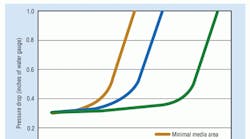ASHRAE recently announced the publication of ANSI/ASHRAE Standard 52.2-2012, Method of Testing General Ventilation Air-Cleaning Devices for Removal Efficiency by Particle Size, which incorporates the arrestance and dust-holding-capacity sections of Standard 52.1, Gravimetric and Dust Spot Procedures for Testing Air Cleaning Devices Used in General Ventilation for Removing Particulate Matter, which was withdrawn in 2009.
“Combining the two standards provides a clean slate to begin significant changes regarding making the method much more technically accurate,” Robert Burkhead, chair of the Standard 52.2 committee, said. “Specifically, we have plans in motion to change the MERV (minimum efficiency reporting value) table ranges, narrow the ambient conditions allowed, and further refine the instrumentation specifications—all in an effort to reduce the variability of the data product from the standard.”
Also new to Standard 52.2 is Appendix J, which provides an optional method of conditioning a filter using fine potassium-chloride particles to demonstrate efficiency loss that might occur in field applications.
The standard addresses three air-cleaner-performance characteristics: the ability to remove particles from an air stream, total dust-holding capacity with arrestance (weight efficiency), and resistance to airflow.
The cost of Standard 52.2-2012 is $46 for ASHRAE members and $54 for non-members. Copies can be ordered by phone at 1-800-527-4723 (United States and Canada) or 404-636-8400, by fax at 678-539-2129, or online at www.ashrae.org/bookstore.











